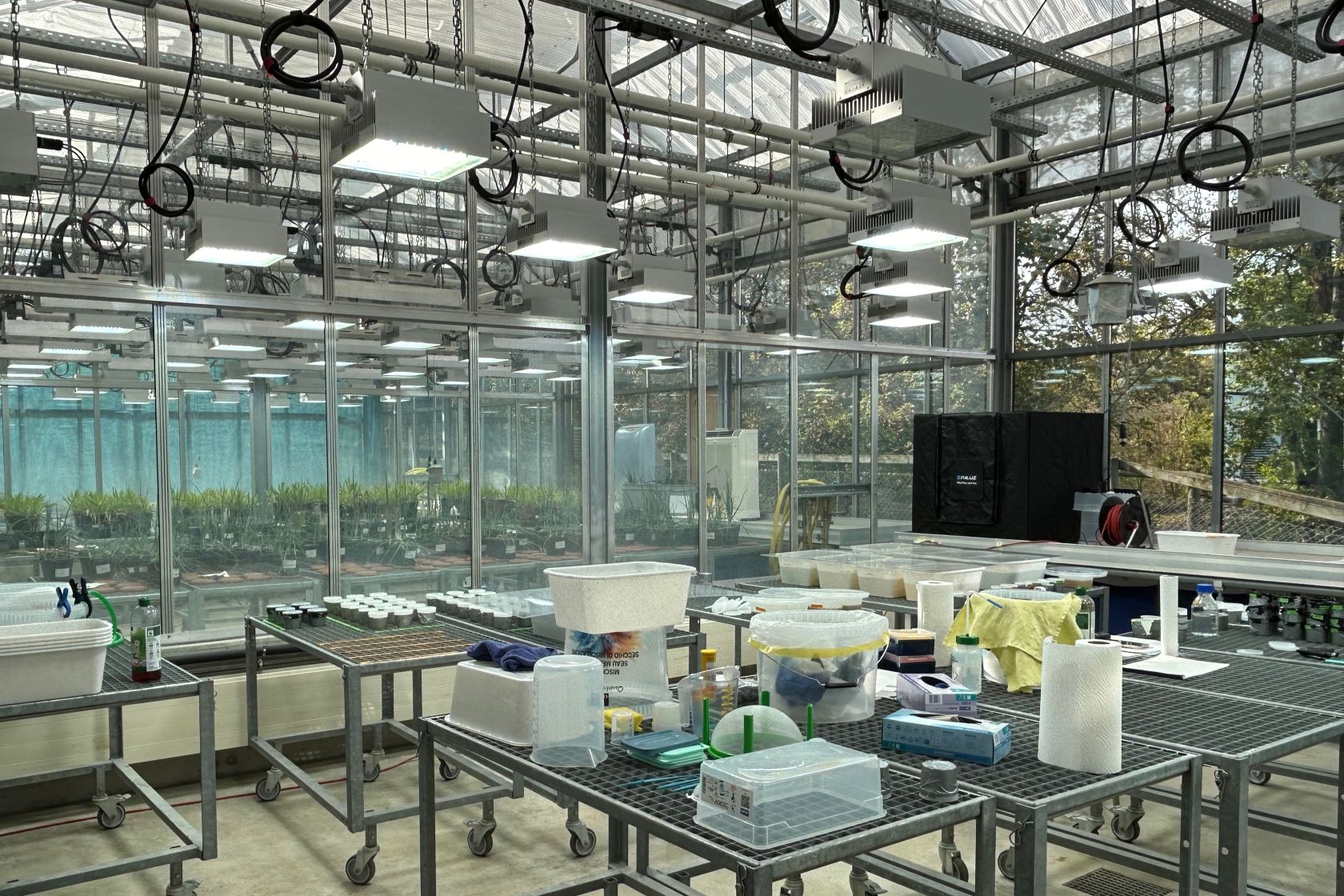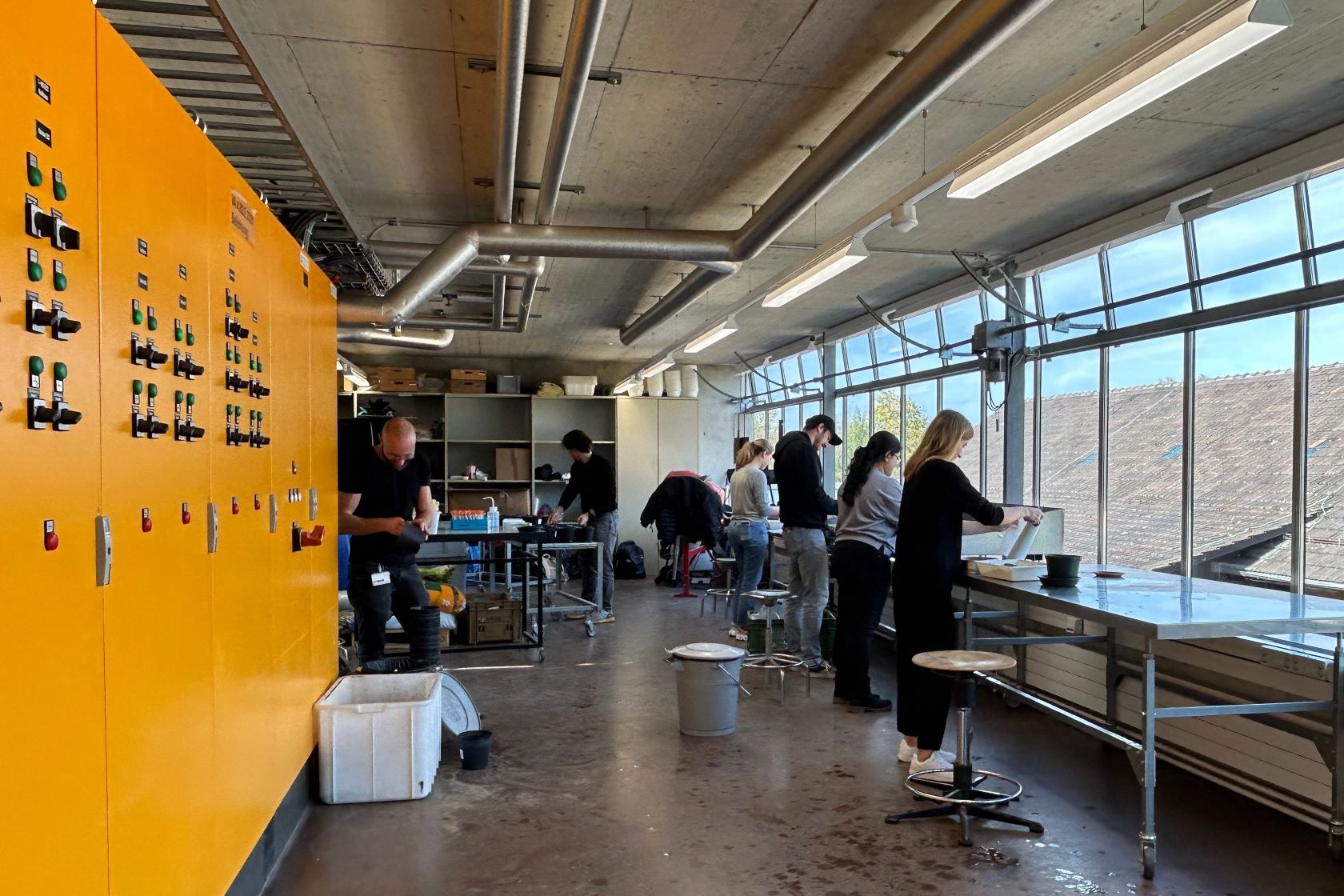Greenhouse and Common Garden at Irchel
Greenhouse at the Irchel campus
Our department's greenhouse is designed with a strong emphasis on environmental sustainability, incorporating features such as rainwater reuse for cleaning and the adoption of energy-efficient LED lighting. It is equipped with six compartments whose condition can be independently controlled.
Within this controlled environment, we conduct cultivation experiments that yield highly reproducible and reliable results. The greenhouse allows for precise management of critical environmental factors, including temperature and humidity. Furthermore, the greenhouse is equipped to effectively manage pest and disease outbreaks, ensuring that external factors do not compromise experimental outcomes. This capability is essential for maintaining the integrity and validity of our research.
Over the years, our greenhouse has played a pivotal role in the cultivation of numerous plant species, contributing significantly to a wide array of research initiatives in biology. It supports large-scale experiments year-round allowing us to undertake long-term studies and comparative analyses.
In addition to serving our department, the greenhouse is open to utilization by other departments within the university, as well as external research institutions. This collaborative approach fosters interdisciplinary research and innovation in plant and ecological sciences.
Experimental garden at the Irchel campus
Our department’s experimental garden is a crucial resource that bridges the knowledge gap between the in vitro experiments conducted in labs and the actual ecosystems in natural environments. This facility allows researchers to explore a wide range of ecological as well as agricultural questions in a controlled yet realistic setting, making it an invaluable tool for advancing scientific knowledge.
Over the years, our research groups have achieved numerous significant outcomes through experiments conducted in this garden. The ability to implement long-term cultivation studies - often lasting several years - within the campus offers a unique advantage, enabling us to monitor and analyze plant growth, soil health, and environmental interactions over extended periods. This capability enhances the robustness of our findings and facilitates deeper insights into complex ecological processes.
Moreover, the experimental field is not only a hub for our department but is also frequently utilized by researchers from external institutions and universities, including ETH Zurich. This collaborative use underscores the field's importance as a shared resource in the scientific community, fostering innovation and encouraging interdisciplinary research. As we continue to explore the potentials of this facility, we remain committed to basic and advanced science and contributing to sustainable practices through our ongoing studies.
Publication List
2025
- Dave Kurath, Sofia J. van Moorsel, Jolanda Klaver, Tis Voortman, Barbara Siegfried, Yves-Alain Brügger, Aboubakr Moradi, Ewa A. Czyż, Marylaure de La Harpe, Guido L. Wiesenberg, Michael E. Schaepman, Meredith C. Schuman. Leaf Spectroscopy Reveals Drought Response Variation in Fagus sylvatica Saplings From Across the Species' Range. JGR. https://doi.org/10.1029/2024JG008404
2024
- Vámos, S., Li, C., Moradi, A. & van Moorsel, S. J. High tolerance to zinc but no evidence for local adaptation in the aquatic plant Lemna minor. Nord. J. Bot. 2024, 1–12 (2024)
2023
- Akiyama, R. et al. Seasonal pigment fluctuation in diploid and polyploid Arabidopsis revealed by machine learning-based phenotyping method PlantServation. Nat. Commun. 14, 5792 (2023).
- López-Angulo, J., Stefan, L., Engbersen, N. & Schöb, C. Ecological and evolutionary effects of crop diversity decrease yield variability. J. Ecol. 111, 1242–1253 (2023).
- Montazeaud, G., Helleu, Q., Wuest, S. E. & Keller, L. Indirect genetic effects are shaped by demographic history and ecology in Arabidopsis thaliana. Nat. Ecol. Evol. 7, 1878–1891 (2023).
- Schöb, C., Engbersen, N., López-Angulo, J., Schmutz, A. & Stefan, L. Crop Diversity Experiment: towards a mechanistic understanding of the benefits of species diversity in annual crop systems. J. Plant Ecol. 16, rtad016 (2023).
- Shimizu-Inatsugi, R., Morishima, A., Mourato, B., Shimizu, K. K. & Sato, Y. Phenotypic variation of a new synthetic allotetraploid Arabidopsis kamchatica enhanced in natural environment. Front. Plant Sci. 13, 1058522 (2023).
- Wuest, S. E. et al. Single-gene resolution of diversity-driven overyielding in plant genotype mixtures. Nat. Commun. 14, 3379 (2023).
2022
- Engbersen, N., Stefan, L., Brooker, R. W. & Schöb, C. Using plant traits to understand the contribution of biodiversity effects to annual crop community productivity. Ecol. Appl. 32, 1–11 (2022).
- Stefan, L., Engbersen, N. & Schöb, C. Rapid transgenerational adaptation in response to intercropping reduces competition. Elife 11, 1–22 (2022).
- Van Moorsel, S. J. The importance of ecotype diversity on duckweed growth with and without salt stress. J. Plant Ecol. 15, 1065–1079 (2022).
- Wuest, S. E. et al. Increasing plant group productivity through latent genetic variation for cooperation. PLoS Biol. 20, 1–21 (2022).
2021
- Chen, J. et al. Diversity increases yield but reduces harvest index in crop mixtures. Nat. Plants 7, 893–898 (2021).
- Shimizu-Inatsugi, R. et al. Metal accumulation and its effect on leaf herbivory in an allopolyploid species Arabidopsis kamchatica inherited from a diploid hyperaccumulator A. halleri. Plant Species Biol. 36, 208–217 (2021).
- Stefan, L., Hartmann, M., Engbersen, N., Six, J. & Schöb, C. Positive Effects of Crop Diversity on Productivity Driven by Changes in Soil Microbial Composition. Front. Microbiol. 12, 660749 (2021).
- Stefan, L., Engbersen, N. & Schöb, C. Crop–weed relationships are context-dependent and cannot fully explain the positive effects of intercropping on yield. Ecol. Appl. 31, 1–12 (2021).
2020
- Hahl, T. et al. Plant responses to diversity-driven selection and associated rhizosphere microbial communities. Funct. Ecol. 34, 707–722 (2020).
2019
- Schmid, M. W. et al. Feedbacks of plant identity and diversity on the diversity and community composition of rhizosphere microbiomes from a long-term biodiversity experiment. Mol. Ecol. 28, 863–878 (2019).
- van Moorsel, S. J. et al. Evidence for rapid evolution in a grassland biodiversity experiment. Mol. Ecol. 28, 4097–4117 (2019).
2018
- Ferrari, A., Hagedorn, F. & Niklaus, P. A. Disentangling effects of air and soil temperature on C allocation in cold environments: A 14C pulse-labelling study with two plant species. Int. J. Bus. Innov. Res. 8, 7778–7789 (2018).
- Milkereit, J., Frossard, E., Stoll, P., Wagg, C. & Niklaus, P. A. Experimental disconnection from common mycorrhizal networks has little effect on competitive interactions among common temperate grassland species. J. Ecol. 106, 2332–2343 (2018).
- van Moorsel, S. J., Schmid, M. W., Hahl, T., Zuppinger-Dingley, D. & Schmid, B. Selection in response to community diversity alters plant performance and functional traits. Perspect. Plant Ecol. Evol. Syst. 33, 51–61 (2018).
- Wuest, S. E. & Niklaus, P. A. A plant biodiversity effect resolved to a single chromosomal region. Nat. Ecol. Evol. 2, 1933–1939 (2018).

